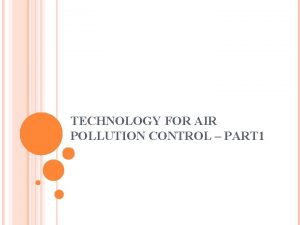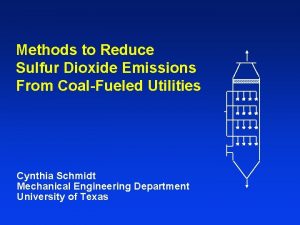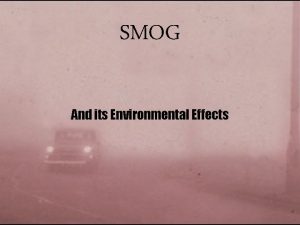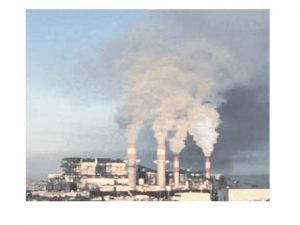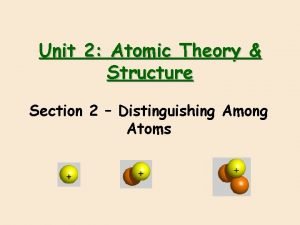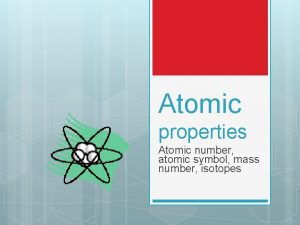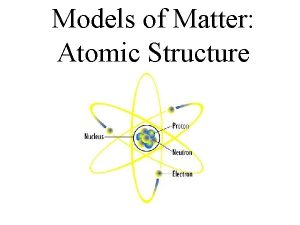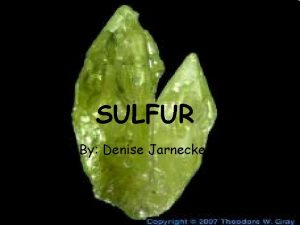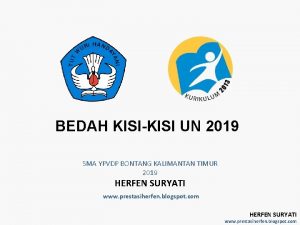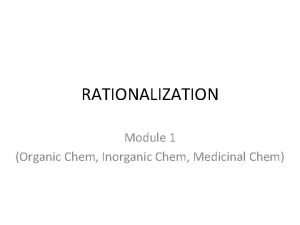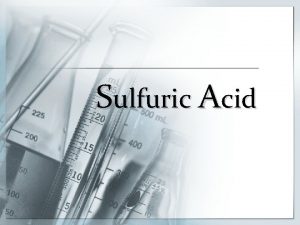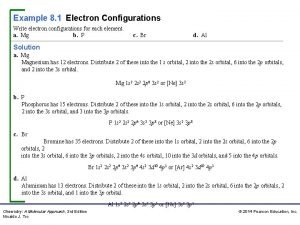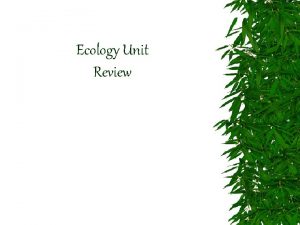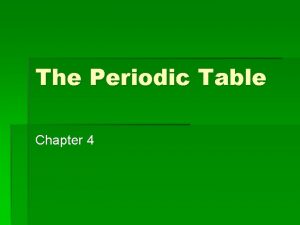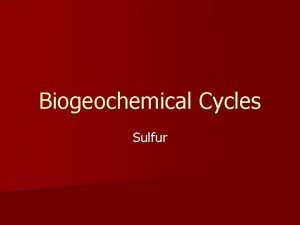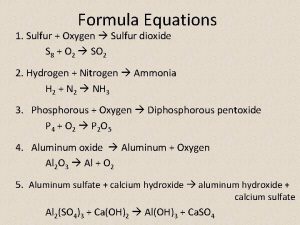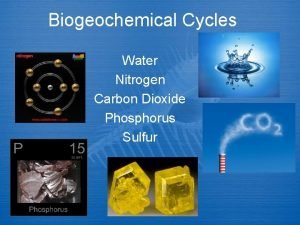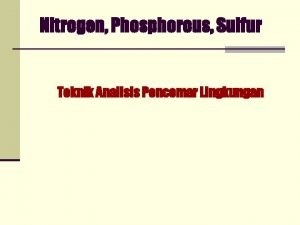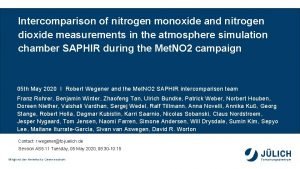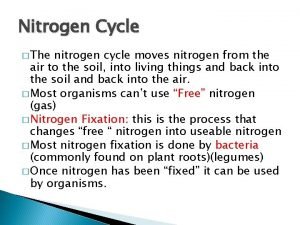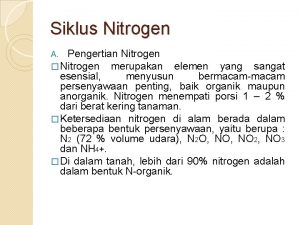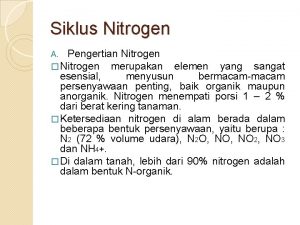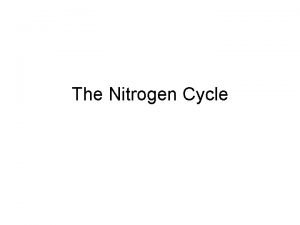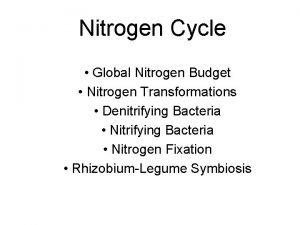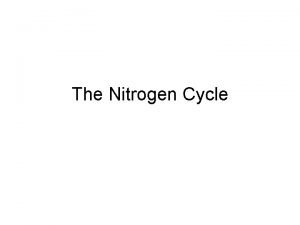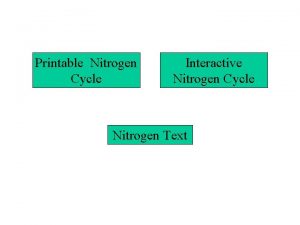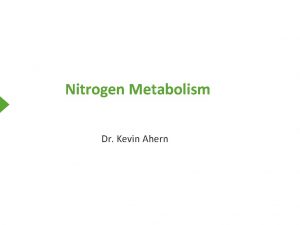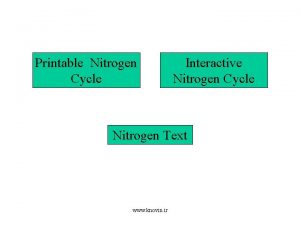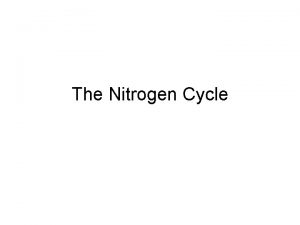Estimation of nitrogen dioxide NO 2 sulfur dioxide


















- Slides: 18

Estimation of nitrogen dioxide (NO 2), sulfur dioxide (SO 2) and ammonia (NH 3) dry deposition over North America from satellite observations Shailesh Kumar Kharol (ECCC), Chris A. Mc. Linden (ECCC), Mark W. Shephard (ECCC), Christopher E. Sioris (ECCC), Jacob Siemons (ECCC), Leiming Zhang (ECCC), Zhiyong Wu (ECCC), Jeff R. Brook (ECCC) Air Quality Research Division, Environment and Climate Change Canada (ECCC) June 04 th – CMOS – 2017, Toronto, ON, Canada 08 th Abstract ID: 9403

Why are we interested in measuring NO 2, SO 2 and NH 3? PM 2. 5 Soil Acidification Water Eutrophication NO 2, SO 2 and NH 3 gets deposited to the ecosystem from the atmosphere. Deposition alters the biogeochemistry and can lead to soil acidification and water eutrophication (e. g. algal Page 2 –blooms) 27, 2021

Dry Deposition Modelled Critical Loads Map Shows areas that are sensitive to acid deposition (i. e. , have a low capacity to neutralize acid) • Yellow, orange and regions are especially sensitive to damage from acid deposition White regions cannot be classified by models • Deposition measurements downwind of source regions are needed to define • their relative contribution to acid deposition and trans-boundary ecosystem impacts The spatial and temporal coverage of satellite observations provides the potential for additional insights on dry deposition in sensitive regions Page 3 – 27, 2021

Satellite Data Satellite Spatial Resolution (Km 2) Spatial Coverage Temporal Coverage NO 2 Ozone Monitoring Instrument (OMI) 13 x 24 Global ~13: 30 (day) SO 2 Ozone Monitoring Instrument (OMI) 13 x 24 Global ~13: 30 (day) Global Twice a day @ ~13: 30 (day) ~1: 30 (night) NH 3 Cross-track Infrared Sounder (Cr. IS) 14 (diameter) Page 4 – 27, 2021

Satellite derived Dry Deposition Flux of 2 NO , SO 2 & NH 3 Meteorological Data (GEM Model) Deposition Velocity (from Big-Leaf model (BLM); Zhang et al. , 2003 (ACP) ) F = - Vd x C Ozone Monitoring Instrument (OMI) NO 2, SO 2 & NH 3 Dry Deposition Flux at Surface Air Quality Model (i. e. GEM-MACH) Profile Shape C Cross-Track Infrared Sounder (Cr. IS) (Shephard & Cady-Pereira, 2015 (AMT)) Surface Concentration 2, SO 2 & NH 3 Page 5 – Of 27, 2021 NO Column Amount of trace gases (i. e. NO 2 & SO 2)

Dry deposition flux of SO 2 over North America for 2005 -2016 (2005 -2008) (2009 -2016) FGD = Flue-gas desulfurization devices • SO 2 dry deposition flux estimated using OMI satellite data over North America. • Decrease in SO 2 concentration and dry Page 6 – 27, 2021 deposition flux due to emission controls (i. e. Kharol etin al. , power (in preparation) FGD devices plants)

Validation of OMI Satellite-derived SO 2 Flux Changes CASTNET OMI CASTNET : Clean Air Status and Trends Network Page 7 fluxes – 27, 2021 compare well, even though dry Changes in SO 2 dry deposition fluxes are calculated using different model velocities

Dry deposition flux of NO 2 over North America for 2005 -2016 • NO 2 dry deposition flux estimated using OMI satellite data over North America. • Show a decrease in NO 2 concentrations and dry Page 8 – 27, 2021 deposition fluxes due to the emission controls Kharoland et al. , power (in preparation) on vehicles plants.

Satellite-derived reactive nitrogen (Nr) dry deposition over North America during warm season (Apr. - Sept) 2013 Main focus is on short-lived nitrogen species (e. g. 3 NH & NO 2) NH 3 hot-spots are mainly located over agriculture regions NO 2 hot-spots are mainly located over densely populated cities and power plants Reactive Nitrogen Nr = NO 2 + NH 3 Page 9 – 27, 2021 Warm season: Apr-Sep, Kharol et al. , (in preparation for 2013 GRL)

Ratio of Nr dry deposition flux over North America Ratio = NO 2 Flux / Total Nr Flux No OMI NO 2 retrieved Mostly NO 2 Mostly NH 3 • NO 2 dry deposition flux hot-spots dominates in urban regions and power plants (e. g. North-East). 10 – 27, 2021 • NH 3 dry deposition flux. Page dominates mostly in agricultural and remote regions (e. g. Mid-West).

Forest fires contribution to the dry deposition of NH 3 in Northwestern Canada MODIS Fire Counts Cr. IS Total Dry Deposition Flux (Fires + Background) Estimated Cr. IS Background Dry Deposition Flux Ratio (Total/Background) Page 11 – 27, 2021 Forest fire emissions are the major source of 3 NH dry deposition in Northern Canada

Concluding Remarks • Presented satellite-derived NO 2, SO 2 and NH 3 dry deposition fluxes over North America using OMI and Cr. IS observations. • Initial validation show that changes in satellite-derived SO 2 dry deposition flux compare well with CASTNET measurements. • Considerable reduction noticed in NO 2 & SO 2 dry deposition flux over eastern North America, mainly associated with implementation of stricter emission controls. • NH 3 emissions have been increasing and are predicted to increase in the future – Due to increasing demands on livestock and crop production. • Forest fire emissions are the major source of NH 3 in Northern Canada. Page 12 – 27, 2021

Thanks! Contact: Shailesh. Kharol@canada. ca Page 13 – 27, 2021

Additional Background Slides Page 14 – 27, 2021

Cr. IS Fast Physical Retrieval Algorithm for NH 3 • Optimal estimation approach (Rodgers, 2000) that retrieves a profile by minimizing the differences between the observed – calculated (radiative transfer model) spectra Starts with an initial guess profile and iterates until it finds a retrieved profile that minimizes the observation – forward model spectral differences Retrieval carried out in two steps: • • – – Surface temperature and emissivity refinement NH 3 profile Observations Cr. IS Observation – Forward Model Calculations H 22 O NH 33 No NH 3 O 33 Initial Guess Retrieval • • Cr. IS most sensitive to NH 3 between 950 and 700 mb (~0. 5 to 3 km) • Not equally sensitive in the vertical and varies from profile-to-profile • Surface retrieved values are driven by sensitivity in boundary layer • ~1 piece of information Page 15 – 27, 2021 Detectability is ~ 0. 25 ppbv under favourable conditions For more details see: Mark Shephard and Karen Cady-Pereira, AMT, 2015

Present and Future Satellite NH 3 Obs. for Air Quality NH 3 Retrieval Sensitivity (Resolution & Noise) Spatial Resolution (km 2) Satellite Spatial Coverage Temporal Coverage Spectral Resolution (cm-1) @970 cm-1 • AIRS Cross-Track Infrared Sounder (Cr. IS) Satellite 13. 5 Global Twice a day 0. 8 (diameter) @ 1: 30 out to 2038) – Launched in fall 2011 (5 missions NASA-Aqua 45 retrieved –(2002) ~1: 30 and 13: 30 overpass product –TESContinuous coverage 4 x 8 spatial Global (until Twice a day 0. 1 2011) @ 1: 30 NASA-Aura – Excellent noise Coarse (2004) ▪ Spectral Noise [K] @280 K @970 cm-1 ~0. 15 ~0. 2 Twice a day @ ~1: 30 0. 625 Below/Limiting Current: 2002 to present Current: 2004 to present (limited coverage) Future: No follow-on planned 2011) ▪ To be turned into a NASA operational product in 2018 Global Average Available to Science Team Members – TES-like sensitivity. Global with IASI-like spatial 0. 5 coverage~0. 2 12 (diameter) Twice a day IASI @ 9: 30 – New prototype algorithm developed in collaboration Metop-A &B (2006 & between Canada (ECCC) and USA (AER, Inc). 14 (diameter) Excellent Future: No follow-on planned spatial TES/IASI ~4 x better noisesampling than Cr. IS SNPP NASA/NOAA (2011) SNPP (2011) Comments Available: https: //tes. jpl. nasa. gov/visualization/ Current: 2006 and 2011 to present Future: 3 -10 years x 3 missions (2006 to 2021) Product: total column : no averaging kernels ~0. 05 (¼ noise of IASI and TES) Current: 2011 - present Future: 5 -8 years x 5 missions (2011 -2038) Available: New ECCC (Mark Shephard) presently over limited time periods and locations: NASA operational product in 2018 IASI-NG Metop-SG (2021) 12 (diameter) Global Twice a day @ ~9: 30 0. 25 (½ of current IASI) ~0. 1 (½ noise of current IASI) IRS MTG-S/ (2022) 4 x 4 GEO Europe Only Every 1 -hr 0. 625 0. 2 Page 16 – 27, 2021 Future 7 -years x 3 missions (2021 -2042) Future (FTS concept derived from IASI) 8 -years x 2 satellites (2022 -2037)

Ozone Monitoring Instrument (OMI) • The Ozone Monitoring Instrument (OMI) is a Dutch/Finnish instrument on the NASA Aura satellite, launched in 2004 • OMI measures nadir (upwelling) UV/visible • radiances (surface reflected + scattered light) Complex algorithms are required to convert the measured spectra into tropospheric NO 2 and SO 2 Vertical Column Densities Extra-terrestrial or number of molecules per cm 2 reflected • OMI spatial resolution is about 15 x 30 • To correct systematic low biases in NASA and km 2 European products over the North America, Environment and Climate Change Canada has reprocessed data over North America Page 17 – 27, 2021 SO 2 NO 2

Cross-track Infrared Sounder (Cr. IS) Cr. IS (NASA/NOAA) NH 3 Retrieval Sensitivity (Resolution & Noise) Satellite Cr. IS NASA/NOAA SNPP (2011) Spatial Resolution (km 2) 14 (diameter) Spatial Coverage Temporal Coverage Spectral Resolution (cm-1) Global Twice a day @ ~1: 30 Spectral Noise [K] @280 K @970 cm-1 0. 625 ~0. 05 (¼ noise of IASI and TES) Comments Current: 2011 - present Future: 5 -8 years x 5 missions (2011 -2038) Available: New ECCC (Mark Shephard) presently over limited time periods and locations: NASA operational product in 2018 Page 18 – 27, 2021
 Sulfur dioxide and limestone
Sulfur dioxide and limestone How to reduce sulfur dioxide
How to reduce sulfur dioxide So2 smog
So2 smog Formation of nitrogen dioxide
Formation of nitrogen dioxide Functional groups chart
Functional groups chart Detritivus
Detritivus Piramida energi
Piramida energi Atoms
Atoms Sulfur atomic number and mass
Sulfur atomic number and mass Sulfur number of neutrons protons and electrons
Sulfur number of neutrons protons and electrons Common uses for sulfur
Common uses for sulfur Daur biogeokimia nitrogen
Daur biogeokimia nitrogen An ion that often shows expectorant action is
An ion that often shows expectorant action is Sulfur extraction
Sulfur extraction Orbital box diagram for sulfur
Orbital box diagram for sulfur Fatality
Fatality Sulfur on mars
Sulfur on mars Sulphur cycle
Sulphur cycle Largest atomic radius
Largest atomic radius
